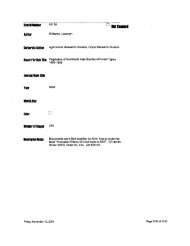Chapter 2: The Military Use of Herbicides in Vietnam - Special ...
Chapter 2: The Military Use of Herbicides in Vietnam - Special ...
Chapter 2: The Military Use of Herbicides in Vietnam - Special ...
Create successful ePaper yourself
Turn your PDF publications into a flip-book with our unique Google optimized e-Paper software.
helicopter and ground application missions). Expert op<strong>in</strong>ion<br />
suggested that an unknown, but apparently large proportion <strong>of</strong><br />
firebase perimeter spray operations were never recorded. <strong>The</strong><br />
degree to which these "unrecorded" operations may have <strong>in</strong>fluenced<br />
exposure is unknown.<br />
After extensive review <strong>of</strong> military records dur<strong>in</strong>g the past two<br />
years, it was apparent that the majority <strong>of</strong> veterans had never<br />
been with<strong>in</strong> two kilometers <strong>of</strong> a sprayed area with<strong>in</strong> a week <strong>of</strong><br />
herbicide application. Additional pilot data reviewed at this<br />
time confirmed this f<strong>in</strong>d<strong>in</strong>g, and the paucity <strong>of</strong> clearly exposed<br />
combat veterans makes it questionable whether a sufficient number<br />
can be assembled to conduct an epidemiological study <strong>of</strong> the type<br />
orig<strong>in</strong>ally designed.<br />
It is clear from the available data that health studies designed<br />
to assess the effects <strong>of</strong> Agent Orange and its associated diox<strong>in</strong><br />
can be done on more appropriate populations than those identified<br />
through military records; e.g., <strong>in</strong>dustrial workers and commercial<br />
herbicide applicators.<br />
Recent advances <strong>in</strong> analytical chemistry may make it feasible to<br />
identify chemical (e.g., 2,3,7,8-TCDD) or biological (DNA adducts)<br />
markers that will permit a more reliable exposure assessment.<br />
RECOMMENDATION: This Science Panel recommends that any study <strong>of</strong><br />
ground troops, which is dependent upon military records for the<br />
assessment <strong>of</strong> exposure to herbicides, not be conducted without an<br />
additional method to verify exposure.<br />
Conclusions<br />
<strong>The</strong> documentation on the use <strong>of</strong> herbicides <strong>in</strong> the military conflict <strong>in</strong><br />
Southeast Asia from 1962 through 1971 is extensive. Nevertheless, the<br />
records were never <strong>in</strong>tended to serve as the basis for health studies or<br />
litigation activities. Health studies <strong>of</strong> the effects <strong>of</strong> the phenoxy<br />
herbicides are difficult enough under conditions <strong>of</strong> normal agricultural<br />
use, but they become more complex when conducted with cohorts briefly<br />
exposed more than two decades ago under conditions <strong>of</strong> war <strong>in</strong> a tropical<br />
environment.<br />
19
















